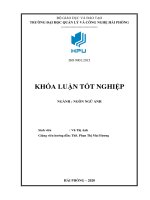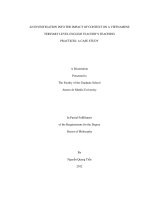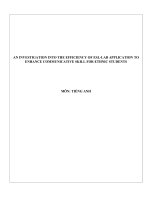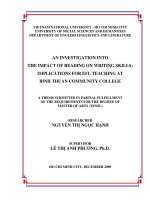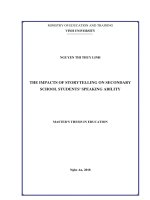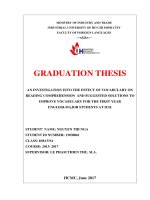An investigation into the impacts of pbl on primary school students’ speaking skill and their perceptions and attitudes towards pbl
Bạn đang xem bản rút gọn của tài liệu. Xem và tải ngay bản đầy đủ của tài liệu tại đây (15.01 MB, 74 trang )
MINISTRY OF EDUCATION AND TRAINING
QUY NHON UNIVERSITY
VO THI THU HIEN
AN INVESTIGATION INTO THE IMPACTS OF PBL
ON PRIMARY SCHOOL STUDENTS’ SPEAKING
SKILL AND THEIR PERCEPTIONS AND
ATTITUDES TOWARDS PBL
Field : Theory and Methodology of English Language Teaching
Code : 8242170011
Supervisor: NGUYEN TIEN PHUNG, Ph.D
ii
BỘ GIÁO DỤC VÀ ĐÀO TẠO
TRƯỜNG ĐẠI HỌC QUY NHƠN
VÕ THỊ THU HIỀN
KHẢO SÁT TÁC ĐỘNG CỦA VIỆC SỬ DỤNG
PHƯƠNG PHÁP HỌC THEO DỰ ÁN TRONG PHÁT
TRIỂN KỸ NĂNG NÓI CỦA HỌC SINH TIỂU HỌC
VÀ NHẬN THỨC – THÁI ĐỘ CỦA HỌC SINH
Ngành : Lý Luận và Phương Pháp dạy học bộ môn Tiếng Anh
Mã số : 8242170011
Người hướng dẫn: Tiến sĩ Nguyễn Tiến Phùng
i
STATEMENT OF ORIGINALITY
I certify that this thesis titled “An investigation into the impacts of PBL on
primary school students’ speaking skill and their perceptions and attitudes towards
PBL” is my work.
Except where reference is made in the text of this thesis, this paper does not
contain any materials published elsewhere or extracted on whole or in part from a
thesis by which I have qualified for or been awarded another degree or diploma.
No other author’s work has been used without acknowledgement in the main
text of this thesis. The thesis has not been submitted for any degree in any other
tertiary institution.
Quy Nhon, October 2023
VO THI THU HIEN
ii
ACKNOWLEDGEMENT
I would like to express my appreciation and deepest thanks to all who have supported,
motivated and stood by me during the long time I conducted this thesis.
Firstly, I would like to express my gratitude to my supervisor, Dr. Nguyen Tien
Phung, who are always kind and devoted to me. He gave me great encouragement
and inspiration when I had troubles in my life, as well as when I got stuck in finding
solutions for my thesis. Undoubtedly, without his valuable supports, this thesis is far
from being successfully completed. Words are not enough to express my gratitude
towards his kindness, encouragement and support to me.
Next, I would like to send my deepest thanks to all the lectures at the Department of
Education and Department of Foreign Languages, who are always devoted and
enthusiastic in transmitting knowledge to students. This knowledge equips me with
intensive knowledge in scientific area and necessary skills to carry out this thesis.
Then, my particular gratitude is sent to the center, the students and the colleague
teachers at AAC English center, who always create most favorable conditions for me
to complete this thesis successfully, and always eager to participate in the
implementation of PBL.
Last but not least, my words of appreciation are sent to my family for endless love,
care, and support so that I could get my thesis done.
iii
ABSTRACT
While project-based learning (PBL) has proven to significantly impact students’ skill
development, especially in speaking skill, many Vietnamese students appear to have
limited awareness of this approach. Consequently, this study was conducted on 60
primary school students at American Australian Center (AAC) to investigate the
impacts of PBL on the development of students’ speaking skill and understand their
perceptions and attitudes towards the use of PBL. The study employed pre-test and
post-test, classroom observations, and semi-structured interviews with 10 students
and 2 instructors to collect data before conducting thematic analysis.
The findings of the study showed that the students’ speaking skill improved after the
projects. Notable enhancements were observed in various aspects, including speech
length and vocabulary, as well as improved pronunciation and intonation, leading to
increased accuracy and fluency. Additionally, the students displayed remarkable
progress in their stage performances, mastering the use of body language and
effectively delivering their messages. Meanwhile, throughout the project experiences,
students encountered both positive and negative aspects. They expressed feelings of
confidence and enthusiasm for project-based learning. However, they also confronted
challenges such as time pressure, competitiveness, and personal obstacles.
Encouragingly, they effectively transformed these challenges into opportunities for
further skill development. In conclusion, PBL is a fruitful method that provides
students with numerous advantages to develop their speaking skill and enhance their
enjoyment in learning English.
iv
TABLE OF CONTENT
STATEMENT OF ORIGINALITY..................................................................................i
ACKNOWLEDGEMENT ...............................................................................................ii
ABSTRACT ..................................................................................................................iii
CHAPTER 1: INTRODUCTION ...................................................................................1
1.1. Rationale.........................................................................................................................1
1.2. Research aim and objectives...........................................................................................2
1.2.1. Research aim ..................................................................................................................................2
1.2.2. Research objectives ........................................................................................................................3
1.3. Research questions ......................................................................................................... 3
1.4. Scope of the study ........................................................................................................... 3
1.5. Significance of the study ................................................................................................. 3
1.6. Organization of the study ............................................................................................... 4
CHAPTER 2: LITERATURE REVIEW.........................................................................5
2.1. Speaking skill..................................................................................................................5
2.1.1. Speaking skill..................................................................................................................................5
2.1.2. Speaking skill teaching ...................................................................................................................5
2.1.3. Speaking assessment.......................................................................................................................7
2.2. Project-based learning (PBL) ....................................................................................... 10
2.2.1. History..........................................................................................................................................10
2.2.2. Definitions ....................................................................................................................................11
2.2.3. Key features of PBL......................................................................................................................12
2.3. The application of PBL in teaching speaking ............................................................... 14
2.4. Students’ perceptions and attitudes.............................................................................. 15
2.5. Previous studies ............................................................................................................ 16
CHAPTER 3: METHODOLOGY .................................................................................20
3.1. Research design ............................................................................................................ 20
3.2. Research setting............................................................................................................ 20
3.3. Participants .................................................................................................................. 21
3.4. Data collection procedure ............................................................................................. 21
3.5. Methods of data collection ............................................................................................ 24
3.5.1. Pre-test and post-test (Speaking test) ...........................................................................................24
3.5.2. Semi-structured interview.............................................................................................................25
3.5.3. Observation ..................................................................................................................................25
3.5. Data analysis................................................................................................................. 26
3.6. Research procedure ...................................................................................................... 28
v
CHAPTER 4: FINDINGS AND DISCUSSION ...........................................................30
4.1. The impacts of using PBL on teaching speaking skill to primary school students
(Research Question 1) ......................................................................................................... 30
4.1.1. Students’ speaking performance within two groups before and after the intervention.................30
4.1.2. Students’ speaking performance between two groups before and after the intervention..............31
4.2. Students’ attitudes toward teachers’ use of PBL in their speaking lessons (Research
Question 2) .......................................................................................................................... 33
CHAPTER 5: CONCLUSION......................................................................................40
5.1. Conclusions................................................................................................................... 40
5.2. Contributions and Implications of the study ................................................................ 41
5.3. Limitations.................................................................................................................... 42
5.4. Recommendations for future research ......................................................................... 43
REFERENCES ............................................................................................................ 45
APPENDICES .............................................................................................................49
vi
LIST OF ABBREVIATIONS
EFL: English as a Foreign Language
ESL: English as a Second Language
OUP: Oxford University Press
PBL: Project-based Learning
1
CHAPTER 1: INTRODUCTION
1.1. Rationale
English is known as a global language, so its role has become more important
than ever. It is a crucial tool for the integration process and considered as a “visa” for
Vietnamese people to integrate into the world (Le, 2015). Therefore, to acquire and
become influent in English is a must for Vietnamese people.
The way English is taught has evolved over time, and several initiatives have
been made to assist Vietnamese students in improving their English language
proficiency. These initiatives are made to assist Vietnamese speakers in improving
their foreign language skills. The location, the learning processes, the teaching
methods, and the learning objectives all influence the most effective teaching strategy
(Brown, 2000). It is also necessary to apply the appropriate curricula and teaching
strategies to enhance the educational processes. The nation's English language
instructors have so received significant training to raise their standards. It also
encouraged educators to actively update their curricula, modernize their teaching
techniques, and incorporate technology into their lessons.
Only educator training, however, is insufficient to improve learners' competency
since it “does not only serve to reinforce the material of the teacher-training curriculum,
but also to model a strategy that teachers in training may later utilize with language
learners” (Stoller, 2006, p.22). Therefore, to improve students' language and speaking
abilities, an efficient and effective teaching style should be used.
Project-based learning is one kind of foreign language instruction that is
thought to help students improve their language abilities and speaking abilities
(Hsieh, 2012). The method emphasizes constructivism, in which students gain new
information and abilities through working on projects, and it is student-centered. It
encourages students to participate actively in their studies because they are crucial to
the learning process. In other words, through the activities involved in carrying out
projects, PBL provides students with an opportunity to further their general English
2
language skills and their speaking ability in particular (Simpson, 2011).
But there are still some obstacles to PBL implementation in Vietnam. First, a
lot of students still employ the exam-based teaching method. At the end of each
course, standardized tests are frequently utilized to assess students' achievement
rather than their progress. Additionally, the majority of teachers lack enough training
in project-based learning techniques for classroom instruction. Many of them are
reluctant to incorporate new techniques into their classrooms in part because “less
teacher talk implies more teacher time” (Cornell & Clarke, 1999, p.94). The students
appear to lack the necessary experience to be prepared for the project-based learning
in the classroom. Moreover, there is still disagreement regarding this strategy
between teachers and students (Beckett, 2002). Even though “most project-work
proponents say that the advantages outweigh the downsides,” some of them
nevertheless demonstrate their discontent with PBL (Alan & Stoller, 2005). It appears
that utilizing English to communicate successfully orally has been a challenge for
Vietnamese educators and students for many decades. Many students still struggle to
speak English fluently, despite receiving high marks on written English proficiency
tests. The primary reason is a lack of understanding of the significance of the English
language (Tran & Baldauf, 2007). Therefore, it is urgent to train the prospective
teachers with approaches which inspire learner to talk and raise their awareness about
the importance of using English.
For these reasons, this study, entitled “An investigation into the impacts of
PBL on primary school students’ speaking skill and their perceptions and attitudes
towards PBL”, is conducted and aims to identify the effect of PBL and students'
attitudes toward its use to understand its effectiveness and students' attitudes toward
its use in classes to enhance students' speaking levels.
1.2. Research aim and objectives
1.2.1. Research aim
This study is carried out in order to measure the effects of using PBL on
teaching speaking skill to primary school students.
3
1.2.2. Research objectives
The study is conducted to 1) examine the effects of using PBL on teaching
speaking skill to primary students, and 2) To gain insights into students’ perceptions
and attitudes towards the teachers’ use of PBL.
1.3. Research questions
To achieve its aims and objectives, the study seeks to answer the following
research questions:
1. To what extent does PBL affect the teaching speaking skill to primary school
students?
2. What are students’ perceptions and attitudes to teachers’ use of PBL in their
speaking lessons?
1.4. Scope of the study
While the PBL has been well documented, its effects on the improvement of
students’ speaking level were poorly understood. The aim of this study is to report on
the practical use and the advantages of using PBL in classes.
The scope of the study is limited to 4 classes and 60 students in the age of 9 to
10 who are in their grade 3 at AAC English Center. The intervention lasted for 2
months and the participants were asked to conduct a pre-test and a post-test, a semi-
structured interview as well as be observed in order to measure and evaluate the
improvement in students’ speaking skill and their attitudes towards this use.
1.5. Significance of the study
While a lot of research has been done on the PBL use, there are not many
studies that have been conducted in Vietnam, especially in the setting of primary
schools. The study’s findings will provide vital information that clarify the procedure
to implement projects into class, as well as advancing the understanding of PBL. It
can be a source of reference for teachers to design effective and suitable projects for
classes. On the other hand, students can anticipate the advantages and disadvantages
before entering the courses with PBL in order that they can maximize the advantages
4
of learning with PBL, benefit more from this approach and overcome its challenges
as well.
1.6. Organization of the study
This research is divided into five chapters:
Chapter 1: Introduction. It consists of the background of the research, research
aims and objectives of the research, and the organization of the paper.
Chapter 2: Literature Review. In this chapter, the writer discusses the
theoretical framework and previous studies.
Chapter 3: Research Methodology. It explains research design, research
method, population and sample, instruments, and data collection and data analysis.
Chapter 4: Findings and Discussion. In this chapter, the writer reveals the
results and discussion of the research.
Chapter 5: Conclusion and Suggestion. The last chapter contains the
conclusion of the research and suggestions.
5
CHAPTER 2: LITERATURE REVIEW
2.1. Speaking skill
2.1.1. Speaking skill
In the modern, globalized world, effective communication is essential for
success in all endeavors. The use of language in communication is common. The
most crucial skill in learning a second or foreign language is speaking. Speaking is
considered to be the most crucial of the four essential language abilities for learning
a foreign or second language. Speaking is the skill that students will be evaluated on
most in real-world situations (Brown & Yuke, 1983).
Speaking skill is a productive skill. Language learners frequently gauge their
proficiency in spoken language as a measure of their language learning achievement
(Richards, 2008). Additionally, Brown and Lee (2015) showed that the ability to attain
pragmatic goals through conversation with native language speakers is a sign of
successful language acquisition. As a result, over the years, the talent has drawn a lot of
interest from researchers and teachers in the field of language teaching and learning.
Speaking is an interactive activity that involves producing, receiving, and
processing information (Burns & Joyce, 1997). Its form and meaning depend not only
on the words or sounds used, but also on the context in which they are used, the
participants who join in the discussion, and the purposes for which they are used. In
other words, speaking involves more than merely producing sounds (Cornbleet &
Carter, 2001). It is a synthesis of sounds, pitch (louder or softer voice), intonation
(rising or falling tone), rhythm (stressed syllables and sentences), and tempo (the
emphasis of words or ideas). Additionally, it relies on the context in which talks
occur, the audience, and the goal of the speech (whether it is a promise, congratulate,
or apologize). Although they used various definitions, it seems that speaking abilities
encompass more than only vocalizations of sounds or words. The interaction of
numerous other factors must be present for the language to be spoken and understood.
2.1.2. Speaking skill teaching
6
Despite its significance, teaching speaking skill has been devalued, and the
majority of EFL/ESL teachers still teach speaking skill by having students memorize
dialogues or practice drills. Traditional speaking exercises in the classroom
frequently take the form of drills where one person asks a question and another person
responds. There is typically just one right response because it is predetermined and
both the inquiry and the answer are structured and predictable. The goal of asking
and responding to the question is to show that learners have the capacity to do so.
Speaking is one of the most challenging skills that language learners must master
(Bueno et al., 2006). Speaking is considered the most important of the four language
skills of English. Even the learners learn the language for so many years, they find it
difficult to speak in real time situations when it is demanded.
Since some EFL/ESL students have a severe fear of making mistakes and
others are just plain shy, and this is true even of native speakers, English teachers
must employ a variety of approaches to help their students improve their speaking
abilities. To encourage students to communicate in English classes, English teachers
can now include some enjoyable exercises in the form of language games and the
teachers should select reading materials that are appropriate to the students' reading
levels. More importantly, teachers should encourage students to participate in class
discussions, where they can greatly enhance their speaking abilities. Additionally, the
students must design their own speaking opportunities both inside and outside the
classroom. The students must also adhere to their teachers' directions in order to
develop their speaking abilities. Since the advice supplied by the teachers is beneficial
to the students, they must sincerely put it into practice in order to communicate
effectively under all conditions. Therefore, in order to develop their students'
speaking abilities, EFL/ESL teachers must use a variety of instructional
methodologies and techniques. In order to succeed in the modern world, learners must
devote all of their energy to honing their speaking abilities and designate more time
to such pursuits.
Brown and Lee (2015) have guided some principles for teachers to remember
when they teach English speaking skill as follow:
7
- Teachers should be sure that teaching activities focus on both accuracy and
fluency. However, the level of focus depends on teachers’ and students’ objectives.
- Teachers are suggested to put themselves in the shoes of their students to
understand their proficiency level and then design appropriate tasks.
- Students’ interest will motivate them to learn and gain much. Therefore,
teachers need to make sure speaking activities are interesting enough to appeal to
students.
- Authentic language and teaching materials are important to motivate
students. Thus, teachers should ensure to provide students with a sense of
authenticity.
- Feedback is important to help students take notice of language elements. For
that reason, appropriate feedback in teaching speaking is crucial.
- Listening and speaking are two skills that are interrelated. When teachers
teach listening, students’ listening skills are also reinforced. Teaching speaking, thus,
should include both listening and speaking.
- Beside giving some suggestions for students to speak out, teachers also
should design some activities for students to initiate language, so that they are more
motivated in speaking.
- Classrooms can be a place where students form their own learning strategies,
such as learning how to ask for clarification, getting someone’s attention, and so forth.
These activities should be included by using authentic materials.
2.1.3. Speaking assessment
2.1.3.1. Types of speaking assessment tasks
According to Brown and Abeywickrama (2018), there are five categories of
speaking performance assessment tasks.
1. Imitative: the ability to simply imitate a word or phrase or possibly a
sentence. The performance criteria may encompass a number of prosodic (intonation,
rhythm, etc.), lexical, and grammatical properties of language.
8
2. Intensive: the production of short stretches of spoken language to showcase
proficiency in a specific area of grammatical, phrasal, lexical, or phonological
relationships (such as prosodic elements – intonation, stress, rhythm, juncture).
Intensive assessment tasks may include tasks like reading aloud, completing
sentences or dialogues, and simple picture-cued exercises.
3. Responsive: Responsive assessment tasks involve interaction and testing
comprehension but at a somewhat limited level, like brief conversations, standard
greetings and small talk, simple requests and comments.
4. Interactive: Interactive assessment tasks include longer and more complex
interactions, sometimes with multiple exchanges or participants.
5. Extensive (Monologue): Extensive oral production tasks consist speeches,
oral presentations, and storytelling where the opportunity for interaction with
listeners is minimal or nonexistent. The language style is often more planned and
formal in extensive tasks.
In this study, the researcher used the fifth type (extensive) because this study
focused on students’ English speaking ability using Project-based learning. With the
application of Project-based learning, students were assigned to prepare a product and
an oral presentation in advance. Moreover, students were expected to be able to
present their tangible products in front of the class.
2.1.3.2. Criteria for speaking assessment
Thornbury (2005) suggests five categories for assessing speaking, namely
grammar and vocabulary, discourse management, pronunciation and interactive
communication as follow:
1. Grammar and vocabulary: candidates are awarded marks for the accurate
and appropriate use of syntactic forms and vocabulary in order to meet the task
requirements at each level. However, teachers need to recognize that it is unfair if
they require their students to speak well-structured utterances because native speakers
produce non-grammatical forms in fast, unmonitored speech.
2. Discourse management: on this scale, examiners are looking for evidence
9
of the candidate’s ability to express ideas and opinions in coherent, connected speech.
The CELS tasks require students to make sentences and produce utterance to convey
information and to express opinions.
3. Pronunciation: candidates are required to produce comprehensible
utterances. It means that they have to produce exact individual sounds, appropriate
linking of words and use correct stress and intonation to convey the intended
meaning.
4. Interactive communication: it refers to candidates’ ability to interact at the
required speed and rhythm with other candidates by initiating and responding
appropriately to fulfill the task requirements. It includes the ability to use functional
language and strategies to maintain and repair interaction and a willingness to develop
the conversation and move the task towards a conclusion.
Similarly, according to Harmer (2007), speaking is a complex skill as it
involves elements such as grammar, vocabulary, pronunciation, fluency, and
comprehension.
1. Grammar
Grammar consists of rules that describe how we use a language. The aim of
grammar is to help individuals acquire expertise in both spoken and written language.
Therefore, understanding grammar is essential for constructing proper sentences in
conversation.
2. Vocabulary
Vocabulary involves the appropriate words used in conversation, is the second
crucial component. Without a comprehensive vocabulary, effective communication,
both written and oral, becomes challenging as individuals struggle to express ideas.
3. Pronunciation
Pronunciation involves producing clear language when speaking. It includes
the phonological process related to grammar components, encompassing elements
and principles determining how sounds vary and pattern in a language. Pronunciation
10
consists of two aspects: phonemes and supra-segmental features. If a speaker cannot
consistently pronounce all the phonemes, understanding them can be difficult for
people from a different language.
4. Fluency
Fluency is the ability to speak fluently and accurately. A fluent speaker speaks
rapidly with minimal pauses and with a few “ums”, or “ers”, indicating that they do
not need to search for words, making their message clearer.
5. Comprehension.
Comprehension is also a crucial component of speaking. It involves the ability
to understand a text, enhancing people’s understanding, and can be assessed through
testing.
In this study, students are expected to achieve Mover A1 level after the course.
Therefore, to suit students’ levels, the study used the five categories from Harmer
(2007) mentioned above as the criteria for speaking assessment: grammar,
vocabulary, pronunciation, fluency, and comprehension.
2.2. Project-based learning (PBL)
2.2.1. History
The Massachusetts Institute of Technology Engineering Faculty is where the
project approach initially appeared and was applied. Through the United States and
the European nations, it later evolved and developed (Wurdingers & Carlson, 2009).
Later in 1918, William Heard Kilpatrick wrote an essay in which he said that PBL
concepts were inspired by students' interests and aided in developing students'
awareness of their lives (Beckett, 2006). Kilpatrick, however, put much more of an
emphasis on the cognitive growth of the students who took part in project work, in
contrast to other academics who later defended the value of group work in carrying
out projects. Additionally, the following researchers who studied PBL added the
significance of learner-centeredness and the strong relationship between students'
interests and their development and acquisition of new language and skills (Kubiatko
11
& Vaculová, 2011).
PBL is recognized as an innovative educational strategy in terms of
pedagogical framework. PBL is a potent strategy that motivates students to apply
what they have learned in new contexts (Bransfort et al., 1999). Another description
of PBL is provided by Savery (2006), who defines it as a constructivist instructional
approach in which teachers guide students while they collaborate in groups or engage
with one another to apply classroom knowledge to real-world issues. Additionally,
PBL is a student-centered approach in which students learn about a subject through
problem-solving activities (Dewi, 2016). PBL aims to support students in gaining
adaptable knowledge, useful collaborative skills, and intrinsic motivation. PBL, or
problem-based learning, is an approach that focuses on the learner and encourages
students to work together and use critical thinking to solve real-world problems.
2.2.2. Definitions
The project-based learning approach literally refers to procedures where
students learn through working on projects. It emphasizes the constructivism
principle, in which teachers assist or guide students as they learn how to generate
knowledge rather than just receive it (Henniger, 2005). More specifically, the
constructivist teaching strategy enables teachers to mentor students as they interact
with one another or work in groups to apply what they have learned in the classroom
to real-world problems (Savery, 2006).
Many academics have made an effort to describe the specifics of this strategy.
For instance, Fried-Booth (2002) characterizes it as a learner-centered method where
students collaborate in a real-world setting to produce final products. According to
him, PBL is intimately related to learner-centeredness, real-world challenges,
participant cooperation, and end results. According to the Malaysian Ministry of
Education's proposal, PBL learning activities should be “long-term, interdisciplinary,
student-centered, and integrated with real-world challenges and practice.” (Malaysia,
2006, p. 3). Beckett (2002), on the other hand, highlights the length of research
projects, whose tasks relate to a variety of joint activities, such as planning, obtaining
12
information, analyzing, and reporting. PBL is a student-centered approach that
emphasizes problem-solving activities as a way for students to learn about a subject.
PBL seeks to assist students in acquiring flexible knowledge, practical teamwork
abilities, and intrinsic drive. Problem-based learning, or PBL, is a methodology that
places an emphasis on the learner and motivates students to collaborate with one
another and apply critical thinking to solve real-world problems (Dewi, 2016)
Given these considerations, PBL's definition has evolved over time. Although
the authors did not completely agree on what PBL was, they all noted that it was
learner-centered, learning by doing, authentic tasks concentrated, using student
participation, and creating end products.
2.2.3. Key features of PBL
The PBL method can be used in any curriculum, subject area, and classroom
setting. Barrows (2011) lists seven characteristics that can be recognized as essential
elements of PBL.
First, PBL is a learner-centered approach. From choosing a topic to decisions
on design, production, and presentation, this component strives to enhance student
initiative and decision-making throughout the project. Projects should include the
proper amount of structure and feedback so that students can make thoughtful
decisions and revisions. By keeping note of their choices, adjustments, and efforts,
teachers and students can acquire pertinent data for assessing the work and growth of
their students.
PBL is defined as a learning process in which students actively design plans,
gather data, analyze it, and present their findings (Beckett, 2002; Stoller, 2006). PBL
always starts with the intention of producing an end product, which students do
through research, and that through this process students learn and make plans to
acquire particular skills and information (Gubacs, 2004). According to him, a project
calls for students to engage in active learning as they explore real-world issues in
order to obtain knowledge and skills. As a result, while taking a course with projects,
students are less likely to rely solely on the teacher and the curriculum to determine


